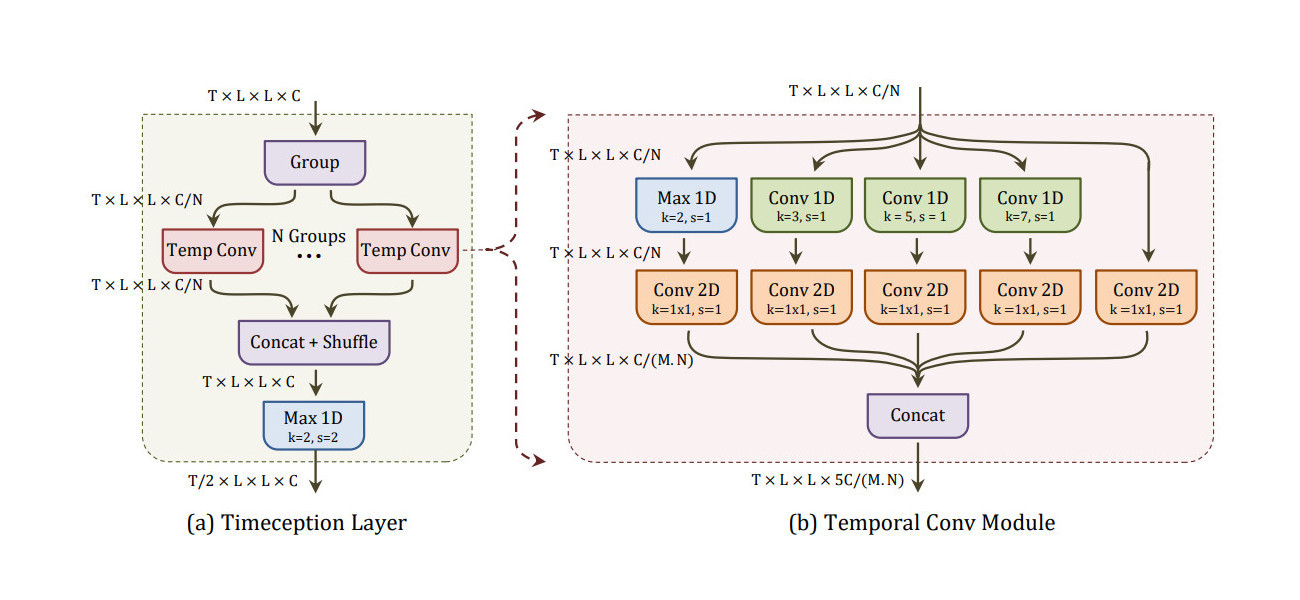This code repository is the implementation for the paper Timeception for Complex Action Recognition.
We provide the implementation for 3 different libraries: keras, tensorflow and pytorch.
Please consider citing this work using this BibTeX entry
@inproceedings{hussein2018timeception,
title = {Timeception for Complex Action Recognition},
author = {Hussein, Noureldien and Gavves, Efstratios and Smeulders, Arnold WM},
booktitle = {CVPR},
year = {2019}
}Using keras, we can define timeception as a sub-model.
Then we use it along with another model definition.
For example, here we define 4 timeception layers followed by a dense layer for classification.
from keras import Model
from keras.layers import Input, Dense
from nets.layers_keras import MaxLayer
from nets.timeception import Timeception
# define the timeception layers
timeception = Timeception(1024, n_layers=4)
# define network for classification
input = Input(shape=(128, 7, 7, 1024))
tensor = timeception(input)
tensor = MaxLayer(axis=(1, 2, 3))(tensor)
output = Dense(100, activation='softmax')(tensor)
model = Model(inputs=input, outputs=output)
model.summary()This results in the model defined as:
Layer (type) Output Shape Param #
================================================
(InputLayer) (None, 128, 7, 7, 1024) 0
(Timeception) (None, 8, 7, 7, 2480) 1494304
(MaxLayer) (None, 2480) 0
(Dense) (None, 100) 248100
================================================
Total params: 1,742,404
Using tensorflow, we can define timeception as a list of nodes in the computational graph.
Then we use it along with another model definition.
For example, here a functions defines 4 timeception layers.
It takes the input tensor, feedforward it to the timeception layers and return the output tensor output.
import tensorflow as tf
from nets import timeception
# define input tensor
input = tf.placeholder(tf.float32, shape=(None, 128, 7, 7, 1024))
# feedforward the input to the timeception layers
tensor = timeception.timeception_layers(input, n_layers=4)
# the output is (?, 8, 7, 7, 2480)
print (tensor.get_shape())Using pytorch, we can define timeception as a module.
Then we use it along with another model definition.
For example, here we define 4 timeception layers followed by a dense layer for classification..
import numpy as np
import torch as T
from nets import timeception_pytorch
# define input tensor
input = T.tensor(np.zeros((32, 1024, 128, 7, 7)), dtype=T.float32)
# define 4 layers of timeception
module = timeception_pytorch.Timeception(input.size(), n_layers=4)
# feedforward the input to the timeception layers
tensor = module(input)
# the output is (32, 2480, 8, 7, 7)
print (tensor.size())We use python 2.7.15, provided by Anaconda 4.6.2, and we depend on the following python packages.
- Keras 2.2.4
- Tensorflow 1.10.1
- PyTorch 1.0.1
We will add all pretrained models for Charades by the end of April.
For testing, start with the script ./scripts/test_charades_timeception.sh.
In order to change which baseline is uses for testing, set the -- config-file using on of the following options.
Timeception on top of 2D-ResNet-152 as backnone.
| Config File | Backbone | TC Layers | Frames | mAP (%) | Model |
|---|---|---|---|---|---|
| charades_r2d_tc3_f32.yaml | R2D | 3 | 32 | 30.37 | Link |
| charades_r2d_tc3_f64.yaml | R2D | 3 | 64 | 31.25 | Link |
| charades_r2d_tc4_f128.yaml | R2D | 4 | 128 | 31.82 | Link |
Timeception on top of ResNet-152 as backnone.
| Config File | Backbone | TC Layers | Frames | mAP (%) | Model |
|---|---|---|---|---|---|
| charades_i3d_tc3_f256.yaml | I3D | 3 | 256 | 33.89 | Link |
| charades_i3d_tc3_f512.yaml | I3D | 3 | 512 | 35.46 | Link |
| charades_i3d_tc4_f1024.yaml | I3D | 4 | 1024 | 37.20 | Link |
Timeception on top of 3D-ResNet-100 as backnone.
| Config File | Backbone | TC Layers | Frames | mAP (%) | Model |
|---|---|---|---|---|---|
| charades_r3d_tc4_f1024.yaml | R3D | 4 | 1024 | 41.1 | Link |
We will add all pretrained models for Kinetics 400 by the end of June.
The code and the models in this repo are released under the GNU 3.0 LICENSE.



